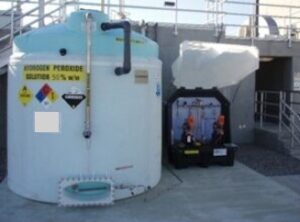Practical Applications of H2O2 Water Treatment in Wastewater Management
 Effective water treatment is essential for managing wastewater in industrial and municipal facilities. Without proper treatment, wastewater can release harmful odors, pose environmental risks, and lead to compliance issues. Hydrogen peroxide (H2O2) is a versatile treatment option that helps facilities address these challenges. It provides an effective way to control odors, reduce contaminants, and improve overall water quality.
Effective water treatment is essential for managing wastewater in industrial and municipal facilities. Without proper treatment, wastewater can release harmful odors, pose environmental risks, and lead to compliance issues. Hydrogen peroxide (H2O2) is a versatile treatment option that helps facilities address these challenges. It provides an effective way to control odors, reduce contaminants, and improve overall water quality.
At Webster Environmental Associates (WEA), we work with wastewater facilities to implement H2O2 treatment strategies that meet regulatory standards and operational needs. Our team offers customized treatment plans that optimize efficiency and ensure long-term success.
How H2O2 is Used in Wastewater Treatment
Hydrogen peroxide is widely used in wastewater treatment due to its strong oxidizing properties. It effectively targets common issues such as odors, organic waste, and microbial growth.
One of the primary uses of H2O2 is oxidizing hydrogen sulfide (H2S), a gas commonly found in wastewater that produces strong, unpleasant odors. When introduced to wastewater, hydrogen peroxide reacts with hydrogen sulfide and neutralizes it. This prevents odors from spreading into the surrounding environment.
H2O2 also helps reduce organic load and improve water clarity. Organic matter in wastewater contributes to odor and can make treatment processes less efficient. Hydrogen peroxide breaks down organic compounds and makes it easier to filter and process wastewater. This results in cleaner effluent and reduces the strain on downstream treatment systems.
In addition, H2O2 plays a crucial role in controlling microbial growth. Wastewater treatment facilities often face issues with bacteria, algae, and other microorganisms that can affect performance and create operational challenges. Hydrogen peroxide helps control unwanted microbial activity without introducing harmful byproducts. This makes it a safe and effective option for many facilities.
Benefits of H2O2 in Wastewater Treatment
Hydrogen peroxide offers several advantages for wastewater management compared to traditional treatment methods. One of the key benefits is improved treatment efficiency. H2O2 breaks down contaminants quickly, which helps wastewater facilities process water faster and more effectively. Unlike some chemical treatments, H2O2 water treatment does not produce harmful secondary pollutants, which results in cleaner discharge water.
Another advantage is lower operating costs. Traditional treatment methods often require ongoing use of expensive chemicals and equipment. Hydrogen peroxide provides an effective treatment option with lower long-term costs due to its efficiency and ability to reduce the need for additional chemicals.
H2O2 treatment also has a minimal environmental impact. It decomposes into water and oxygen after use, so it is an environmentally friendly option that aligns with sustainability goals. Facilities that use hydrogen peroxide can reduce their reliance on harsh chemicals and improve overall environmental compliance.
Challenges of Implementing H2O2 in Wastewater Facilities
While hydrogen peroxide is effective, successful implementation requires careful planning and management. One challenge is determining the correct dosage and application methods. Too much or too little H2O2 can lead to inefficiencies or incomplete treatment. It is important to conduct proper testing and monitoring to achieve the right balance for each facility’s needs.
Another consideration is integrating H2O2 treatment with existing processes. Wastewater facilities often use multiple treatment technologies, and adding hydrogen peroxide must align with current operations. Proper system design and planning are necessary to ensure smooth integration without disrupting existing processes.
Long-term monitoring and adjustments are also crucial for maintaining treatment effectiveness. Regular testing and performance reviews help make sure the system continues to meet treatment goals and comply with regulations. Adjustments may be needed over time to respond to changing wastewater conditions or regulatory updates.
How WEA Helps Facilities Achieve Treatment Goals
 At Webster Environmental Associates, we understand the complexities of wastewater treatment and the challenges facilities face. Our team creates strategies to help facilities optimize their use of H2O2 for odor and contaminant control.
At Webster Environmental Associates, we understand the complexities of wastewater treatment and the challenges facilities face. Our team creates strategies to help facilities optimize their use of H2O2 for odor and contaminant control.
We start with a thorough evaluation of the facility’s treatment needs. This includes identifying odor sources, analyzing water quality, and determining the most effective treatment approach. Based on this assessment, we develop a customized treatment plan that aligns with the facility’s goals and budget.
To maintain compliance, we offer regular testing and monitoring services. Our experts conduct routine evaluations to measure treatment performance and make necessary adjustments. This proactive approach helps facilities stay compliant with environmental regulations and avoid potential fines.
WEA also provides staff training to support system efficiency. Proper training ensures that facility personnel understand how to operate and maintain the H2O2 treatment system effectively. Our team offers hands-on guidance to help staff monitor performance and troubleshoot potential issues.
Learn More About H2O2 Water Treatment Today
Hydrogen peroxide is a reliable and effective option for managing wastewater odor and contaminants. It offers a sustainable and cost-efficient way to improve water quality while meeting regulatory requirements.
WEA provides expert support to help wastewater facilities implement and maintain H2O2 treatment systems. Our team works closely with clients to develop odor control systems that fit their needs and facilitate long-term success. Contact WEA today to learn how we can help your facility achieve better wastewater management with hydrogen peroxide treatment.
